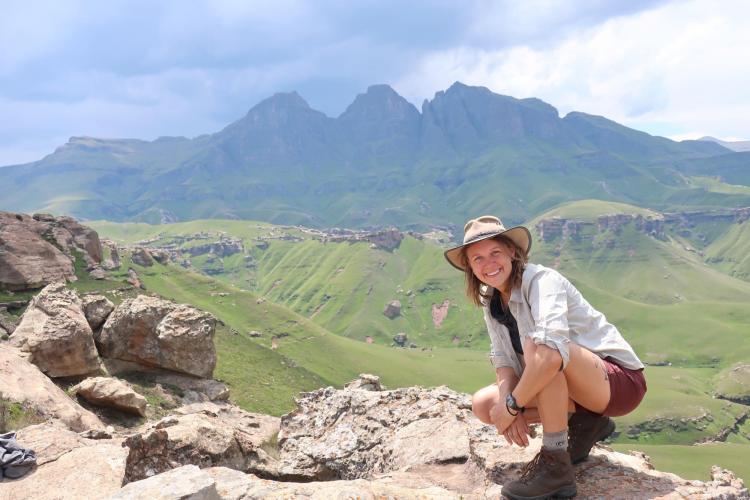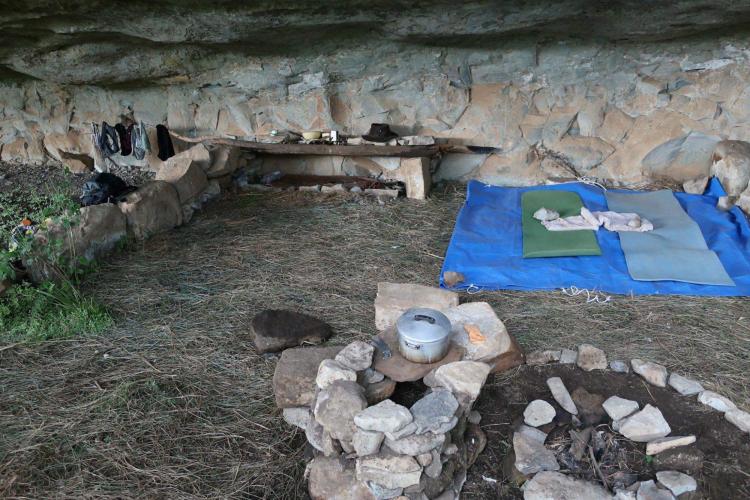Living in African cave to study flower pollinated by hummingbird-like fly
Louise Barton wants to know how evolution itself happens, and tracking this fly is one way to do that
Louise Barton, a graduate student in ecology and evolutionary biology at the University of Colorado Boulder, was not in her cave when I bumped into her in South Africa in February. She was standing at her red Renault Kwid rental car in the small town of Clarens, and she and her field assistant, Keely Lawrence, looked like they had been hiking for days.

Louise Barton in the Drakensberg Mountains in South Africa. Photo by Keely Lawrence. At the top of the page: A long-tongued fly taking a sip of nectar from the flowers that Barton studies in the Drakensberg. Photo by Steve Johnson
“Are you hikers?” I asked them, hoping to get some tips about nearby trails.
“Yeah,” Barton said.
Her American accent caught me off-guard, because Clarens qualifies as the middle of nowhere.
But there we were, three Americans standing near South Africa’s Drakensberg Mountains, where Barton, I learned, was studying how it was that a flower pollinated by a fly that looks like a hummingbird evolved — and may still be evolving.
In Boulder, Barton lives in an A-frame mountain house about 10 minutes outside of town, but in South Africa, for two months, she and Lawrence lived in a cave in the Drakensberg, where their only other company was a troop of about seven baboons and a pair of geckos.
“Occasionally, a baby baboon would jump over the wall, and the mom would jump over and grab the baby, throw the baby over the wall, give us a mean look, and then leave us alone,” Barton said.
They lived in the cave not out of convenience, but because research funding for Barton’s work was scant this year. Nevertheless, she paid for travel costs out of pocket, found the cave, and did her science. The two woke up every morning at 5 a.m. with the dawn, made porridge, stretched and hiked two miles to their car so they could get to their field sites.

The cave home of Louise Barton and her field assistant Keely Lawrence. Photo by Louise Barton
“Drakensberg” is Afrikaans for “Mountain of the Dragons.” This is fitting because Barton’s fly, Prosoeca ganglbauri, looks like something out of a fairy tale.
“It has a tongue that’s too big for it to efficiently land,” she said. “They’re kind of dopy little creatures.”
Barton wants to know how evolution itself happens, and tracking this fly is one way to do that. That’s because there is a flower, Zaluzianskya microsiphon, that’s tubular—the perfect shape for a sword-like tongue—and Barton suspects that the flower and the fly have co-evolved. That is, over many generations, the shape of the flower has driven the evolution of the fly’s tongue, and vice versa.
Barton thinks this evolutionary dance may still be happening. Trekking over the mountains this year, she found that flowers higher in elevation have shorter tube lengths than flowers at lower elevations. The same, it seems, goes for the flies: “at low elevations, long tongues, and at high elevations they have significantly shorter tongues,” she said. This could very well signify the emergence of new species, but Barton will have to wait for DNA analyses—themselves dependent on uncertain funding—of the flowers to know for sure.
It was heavy rains that drove Barton and Lawrence from their cave and from the flowers and the flies the day I met them in Clarens. Scant funding for scientists, it seems, is only good for journalists looking for stories to write.
Lucas Joel is a freelance journalist who writes stories about the natural sciences.

